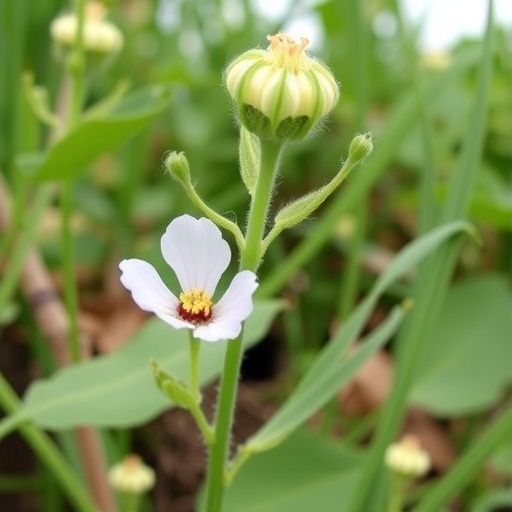In the relentless fight against parasitic infections, the quest for new, effective compounds has taken researchers deep into the ancient pharmacopeia of traditional medicine. One such investigation, recently published in Acta Parasitologica, dives into the potent anticestodial properties of Evolvulus nummularius, a herb long cherished in North-East Indian folk medicine. This study not only sheds light on the plant’s anthelmintic effectiveness but also elucidates its bioactive profile through sophisticated gas chromatography–mass spectrometry (GC-MS) analysis, potentially heralding a new frontier in antiparasitic drug discovery.
Parasitic cestode infections, commonly known as tapeworm infestations, continue to pose significant global health challenges, particularly in tropical and subtropical regions. Such infections often lead to debilitating morbidity, ranging from nutritional deficiencies to severe organ damage. Traditional anthelmintic agents increasingly face limitations due to rising drug resistance, adverse side effects, and prohibitive costs. Therefore, research into alternative, plant-based therapies has intensified, with the aim of uncovering safer and more accessible remedies.
Evolvulus nummularius, a creeping perennial herb native to the Indian subcontinent, has been historically utilized by indigenous communities for its medicinal virtues. Despite its widespread ethnobotanical use, empirical evidence detailing its efficacy against parasitic worms has been scarce. The recent study by Deori et al. intricately examines this lacuna by systematically assessing both the in vitro and in vivo anticestodial activities of the plant’s extracts, thereby providing a robust scientific foundation for traditional claims.
The experimental approach employed involved treating cestode parasites extracted from model hosts with varying concentrations of E. nummularius extracts, meticulously recording the resultant morphological and physiological changes. The data revealed a significant dose-dependent parasite mortality rate, underpinning the potent helminthicidal capabilities of the plant. Such findings not only pave the way for therapeutic application but also hint at novel mechanisms of action distinct from conventional anthelmintics.
To unravel the chemical basis underlying these effects, the study incorporated GC-MS analysis—a powerful analytical chemistry technique that allows precise identification and quantification of complex mixtures of phytochemicals. This method confirmed the presence of diverse bioactive compounds within the plant, including alkaloids, flavonoids, terpenoids, and phenolic acids. Many of these classes are known for their antiparasitic, antioxidant, and anti-inflammatory properties, thus providing a biochemical rationale for the observed biological activity.
One of the remarkable aspects of this research is its integration of ethnomedicine and modern analytical techniques, bridging gaps between traditional knowledge and contemporary pharmaceutical science. This fusion not only validates the therapeutic potential of Evolvulus nummularius but also inspires further exploration into other underutilized medicinal plants with similar ancestries. The study’s findings emphasize the wealth of bioresources harbored in biodiversity hotspots like North-East India, advocating for their conservation and sustainable use.
Moreover, the implications of discovering plant-based anticestodial agents extend beyond veterinary and human medicine. Agricultural sectors battling parasitic infections in livestock stand to benefit immensely, as herbal anthelmintics offer an eco-friendly and cost-effective alternative to synthetic drugs. Considering the economic burden of parasitic diseases on rural communities dependent on animal husbandry, the adoption of such natural remedies could revolutionize parasite management practices.
The intricate chemical profiling conducted by Deori and colleagues revealed several compounds with previously reported antiparasitic effects, including phytosterols and volatile oils. These may operate by disrupting parasite tegument integrity or interfering with metabolic pathways essential for parasite survival. The multifaceted action spectrum is particularly advantageous in circumventing resistance mechanisms that plague many current anthelmintic drugs.
It is worth noting that the study’s methodological rigor involved appropriate controls and replication, ensuring the reliability of the results. Furthermore, it delineated toxicity profiles, establishing a therapeutic window where the extracts manifested efficacy without harmful effects on host tissues. Such safety considerations are critical for progressing towards clinical applications and regulatory approval.
Beyond its scientific merit, this work resonates with the global movement towards integrating traditional medicine into mainstream healthcare frameworks. Recognizing the vast reservoir of plant-derived therapeutic agents aligns with the World Health Organization’s strategy to promote affordable, culturally acceptable health solutions. As conventional drug pipelines face stagnation, nature-inspired avenues like that illuminated by this study become increasingly valuable.
The broader parasitology community is taking keen interest in these findings, as they offer a blueprint for semi-purified extract development and potential synthetic optimization. The detailed GC-MS fingerprints serve as a reference for standardizing dosage forms and ensuring reproducibility across batches, a vital step towards pharmaceutical product development.
Future research trajectories inspired by this work may involve isolating individual compounds responsible for the anticestodial effects, deciphering their precise molecular targets, and evaluating synergistic interactions within the complex phytochemical matrix. In-vitro mechanistic assays combined with in-vivo pharmacokinetics and pharmacodynamics studies will be essential to fully harness the therapeutic promise of Evolvulus nummularius.
In summary, this groundbreaking research epitomizes how age-old wisdom can ignite contemporary innovation. By meticulously validating the anticestodial efficacy of a traditionally employed plant and decoding its chemical arsenal, scientists have opened new avenues for combatting parasitic diseases. With the ever-increasing threat of drug-resistant helminths, nature’s pharmacopeia, exemplified by Evolvulus nummularius, may hold the keys to future parasitic control strategies that are safe, effective, and sustainable.
Subject of Research: Anticestodial efficacy and phytochemical analysis of Evolvulus nummularius, a traditional anthelmintic plant from North-East India.
Article Title: Anticestodial Efficacy and GC-MS Study of Evolvulus nummularius, a Traditionally Used Anthelmintic Plant of North–East India.
Article References:
Deori, K., Yadav, A.K., Biswas, T. et al. Anticestodial Efficacy and GC-MS Study of Evolvulus nummularius, a Traditionally Used Anthelmintic Plant of North–East India. Acta Parasit. 70, 191 (2025). https://doi.org/10.1007/s11686-025-01131-x
Image Credits: AI Generated




